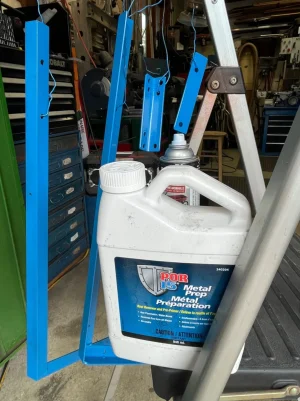i have measured/fabricated and installed thousands of feet of picket handrail similar to what you have posted, some of the tips i can give you
layout your posts on site and shoot the elevations at the post locations, it is very hard to see even 1/2" of slope on 8'
use solid bar for your pickets, hss pickets rot out quickly, make sure your posts are 100% sealed, look over them, if there is even a pinhole at the top they will either rust out, or fill with water and burst in a few years, i doubt you will end up with a perfect 4" spacing on your pickets, what you are shooting for is no more than 4", once you know your post spacing divide up the opening so that you get a spacing close to but no more than 4" apart
you dont need gussets on your baseplates, standard baseplates for a 1070 rail is 100x100, 4 9/16 holes 20mm in from the edge, 3/8 titen anchors look the best, 3/8 kwik bolts work but look like crap imo, be careful not to go to wide, you can blow out that pony wall if your edge distance on the anchors is to small...if your close to the edge use epoxy for your anchors, epoxy doesnt have that outward pressure that a kiwk bolt or titen anchor does, and wont blow the side out, 100mm embedment is plenty, 75mm will still be ok
unless the concrete is massively sloped or bumpy, dont bother with the chisel or diamond cup wheel, your baseplates will not be 100% square on the pipe, you will be shimming to plumb it if you weld the baseplates on in the shop, guaranteed, i have never installed a handrail and not had to shim
the easiest way to plumb a rail up is to toss a small washer in the center of the baseplate and use the anchors to plumb the rail, dont try to fart around putting small shims under the sides
if you want to not shim and have the most solid handrail without tieing it into the building, or having already embedded plates to weld to, the best thing is to have the baseplates loose, anchor them down flat to the concrete and weld your handrail to the plates in position, this is the most solid way of doing it without having cast in plates
i dont see a height for your grab rail, the height you are looking for is 920mm from each nose of the stair to the top of the grab rail measured vertically, that is the code height, and it is what everyone is used to, higher or lower and it will feel off, the transition from slope to flat at the bottom is normally done where that 920mm hits the floor, 2x1 may also feel a bit on the large size, grab rail is quite often made from 42mm od pipe, 48mm (the next standard size) usually feels quite big, might want to grab a piece and see how it feels in the hand

